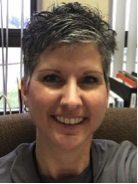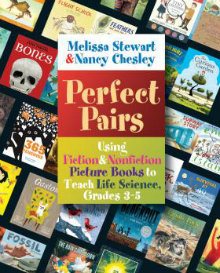Learning Life Science with Picture Books
Perfect Pairs: Using Fiction and Nonfiction Picture Books to Teach Life Science, Grade 3-5
By Melissa Stewart and Nancy Chesley
(Stenhouse, 2016 – Learn more)
 Reviewed by Pam Hamilton
Reviewed by Pam Hamilton
The big buzzword in elementary science in recent years has been “hands-on.” While hands-on lessons are ideal for teaching some science concepts that students can easily see and experience – weather conditions, properties of matter, or light and sound in their world – these lessons are not so ideal for teaching life science concepts.
 Students can’t safely and effectively experience predator-prey relationships. It’s not environmentally sound to have them experience habitat loss. They can’t really grasp the concept of interdependence of living things through hands-on activities. And they aren’t usually able to observe lots of different animals or fully explore habitats from inside a classroom.
Students can’t safely and effectively experience predator-prey relationships. It’s not environmentally sound to have them experience habitat loss. They can’t really grasp the concept of interdependence of living things through hands-on activities. And they aren’t usually able to observe lots of different animals or fully explore habitats from inside a classroom.
Perfect Pairs addresses all of these challenges by offering a wonderful alternative that is both effective and, just as importantly, fun!
Picture books bring world to life
Perfect Pairs uses high-quality, science-themed children’s picture books to bring a world of plants, animals, ecosystems, and natural processes to life, allowing students the opportunity to explore science topics they can’t learn by experiencing it themselves.
But we know that students can’t acquire the understanding they need by just reading about these key concepts. They need to participate in a wide range of experiences that introduce and reinforce scientific ideas. This allows them to apply their new knowledge in different situations. That’s what we strive for, right?
In the words of authors Melissa Stewart and Nancy Chesley:
Perfect Pairs marries the wonderful array of science-themed children’s fiction and non-fiction picture books currently available with authentic, engaging minds-on activities and investigations.”
Beyond science study
As if helping students synthesize scientific ideas wasn’t enough good news, the authors note that, because the books that they choose are of such high quality, they have noticed how the authors’ techniques begin to appear in student writing assignments!
And (yes, there’s even more) reading and working with these picture books during these science experiences gives the students practice that prepares them to read and respond to similar passages on standardized tests!
However, the authors also want to make it very clear the purpose of Perfect Pairs is to teach science. These other bonuses are just that—bonuses.
Lessons begin with Wonder Statements
To teach the lessons, they utilize a Wonder Statement because authentic science always starts with a question. Each Wonder Statement goes along with a Next Generation Science Standard Performance Expectation. The Wonder Statement is followed by a Learning Goal, which is the new knowledge the students are expected to gain from the lesson. These statements begin the investigative process.
The authors use a 3-step model for their investigative process: Engaging Students, Exploring With Students, and Encouraging Students to Draw Conclusions. These three steps can each take one or multiple days.
Engaging Students involves a common experience and lasts about 30-45 minutes. Exploring With Students is the heart of the investigative process where teachers guide students in coming up with a plan to address the Wonder Statement. This part usually takes about 45 minutes. Encouraging Students to Draw Conclusions is the final step and generally requires two 45-minutes blocks of time.
The authors also encourage teachers to have students use a Wonder Journal, similar to a professional scientist’s notebook. There are detailed suggestions on how to introduce and use the Wonder Journal.
Lessons support standards
The biggest part of the book are the lessons. There is a section of third grade lessons, a section of fourth grade lessons, and a section of fifth grade lessons (you can look at the entire book here). They have made it so easy and inexpensive – a perfect resource for teachers with limited time and limited resources (who doesn’t fall into those categories?).
Not only do these lessons support the Next Generation Science Standards, but they also support Common Core State Standards for English Language Arts. They list all of the picture books for you, as well as the author and year of publication, so you can find them easily. (I was able to locate most all of them at my favorite new & used site Better World Books.)
The appendices are great: Appendix A lists the Science and ELA standards that are addressed in each lesson. Appendix B has a plethora of teaching aids, such as graphic organizers and various handouts.
I can’t wait to share this resource with teachers, and, if you teach science in grades 4, 5 or even 6, I would encourage you to run out and get this book. Or—better yet—convince your principal to get it for you!
Read another review of Perfect Pairs here at MiddleWeb
Pam Hamilton is an Intermediate Literacy Coach at Middlebury Community Schools in Middlebury, Indiana. She is in her 23rd year of teaching. In those 23 years, she has taught 1st and 2nd grades, Reading Recovery, and Title I Intervention groups before becoming a 3-5 literacy coach in 2013.

































